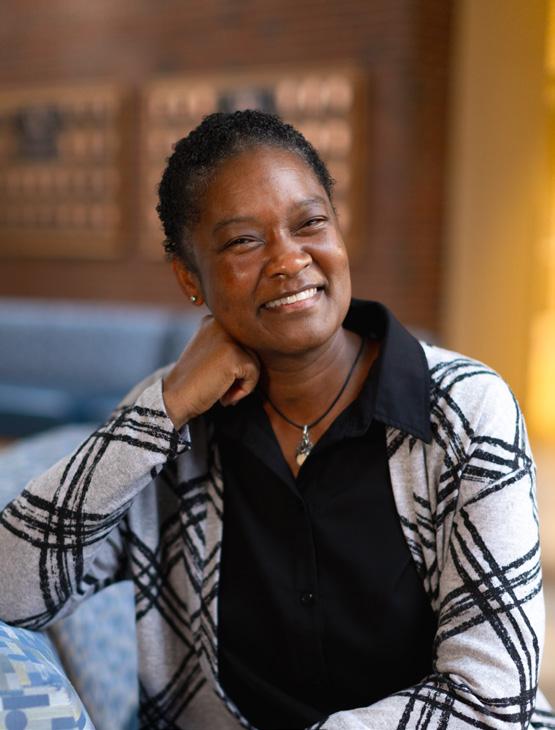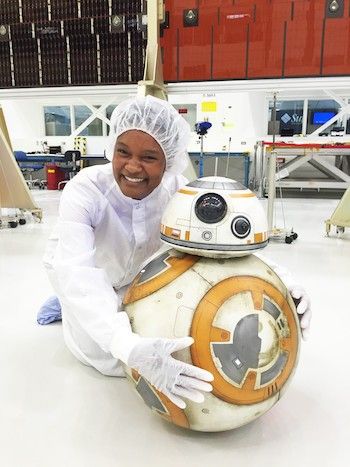
12 minute read
Defying Gravity
From Louisville stargazer to NASA torchbearer, Tracy Drain turned sci-fi dreams into real-life missions across the cosmos
By Dan Knapp
It’d be easy – too easy – to reductively describe Tracy Drain ’98 EN with the kind of pop culture taglines that get remixed and slapped on coffee mugs: “Boldly going where no girlboss has gone before.” “One small step for man, one giant leap for womankind.” “Houston, we’ve got a problem (and she’s got the answers!).” But while these lines are catchy enough to look right at home on the shelves of a kitschy gift shop near Area 51, they barely scratch the surface of this trailblazing woman – someone whose career at NASA’s Jet Propulsion Laboratory (JPL) has contributed to missions from Mars to Europa, reshaping our reach into the cosmos.
Throughout the past quarter-century, Drain’s contributions to science missions have changed the way we think about planets within, and beyond, our solar system. Her work isn’t just a string of high-profile missions; it’s a collection of interplanetary puzzles with real scientific stakes. Each one demanded technical precision, creative thinking and the ability to lead diverse teams – skills Drain wields like a pilot navigating a starship through a wormhole.
What sets Drain apart isn’t just what she builds – the ships, the teams, the relationships – but how she shows up. In a field still light years away from full equity, she’s become a rare and powerful symbol of inclusion. She appears in NASA outreach videos, speaks at schools, mentors novice scientists, and has even been featured by National Geographic Live. She’s not there as a token or a talking head. She’s there because she knows representation fuels the next generation. For young Black girls who haven’t seen themselves in lab coats or mission control, Drain sends a simple, vital message: space is for you, too.

WE HAVE LIFT-OFF
Drain grew up in Louisville, Kentucky, where her fascination with space took root early. She was the kind of child who loved staring at the stars, voraciously devoured science fiction novels and asked big questions about what lay beyond the sky. By the time she was 7, she’d caught what she calls “the space bug.”
Her mother, Eddie Mae Rice, was instrumental in nurturing that curiosity. Rice encouraged her children to wonder widely – and never made them feel silly for doing so. Their home was a place where imagination was fuel and inquiry opened doors.
It was also a house steeped in sci-fi. The family would curl up together in front of the television to watch programs like “Star Trek,” “Battlestar Galactica” and “Star Trek: The Next Generation” – stories that expanded young Drain’s sense of what was possible in the universe, and in herself.
“Growing up, I was interested in a whole bunch of things,” Drain says. “But one of the through-lines was that my mom introduced my brother and me to science fiction. We inherited that love of space and exploration from her.”
Movies like “Star Wars” and books like H.G. Wells’ “War of the Worlds” and Madeleine L’Engle’s “A Wrinkle in Time” further fed her fascination. But it wasn’t just the spectacle that stuck with her –it was the sense of purpose, the ethical questions and the model of thoughtful leadership.
When asked about her favorite sci-fi character, she pauses and then laughs. “No one has ever asked me that before. But I was always so impressed by Jean-Luc Picard. He was even-keeled, respectful, kind to everyone. He encouraged his crew to think outside the box and supported them in what they needed to do. I just loved his modeling of what an excellent leader could be.”
Decades later, those same traits possessed by the fictional captain of the U.S.S. Enterprise define her leadership at JPL.
Drain has often named Isaac Asimov and Arthur C. Clarke among her favorite science fiction authors. It’s a fitting coincidence that Clarke’s 1987 novel “2061: Odyssey Three” imagined a spacecraft reaching Jupiter’s moon, Europa, decades before NASA made it the focus of a real-life mission.
Today, Drain serves as the chief engineer in operations for NASA’s Europa Clipper mission, a flagship project investigating whether that same icy moon could support life. It’s the kind of story that could leap straight from the pages of a sci-fi novel – only this time, Drain isn’t just reading it; she’s helping bring it to life.
Drain’s job on the Europa Clipper mission touches nearly every part of the spacecraft – from hardware to timelines to troubleshooting the unexpected. Given the enormity of her responsibility, it’s no small feat to boil her role down into a few words. But Drain has a knack for making the complex sound simple.
“I’m responsible for making sure we look ahead and figure out things that could be risky or problematic for the spacecraft and the mission and then take steps to keep those key things from happening – or get ready to deal with them if they do crop up and surprise us,” Drain says with a broad smile.
CHARTING HER COURSE
Even before she set foot on a NASA campus, Drain was already orbiting in her own academic stratosphere. Math and physics came easily to the young scholar. And, more importantly, they could be explained.
“Through middle and high school and on into college, I really clicked with math,” Drain explains, who also says she enjoyed puzzles as a child and found tests “fun.” “Math and physics just made sense to me. I loved how everything built on the previous fundamentals that you learned.”
A National Merit Scholar in high school, Drain attracted interest from several colleges, though the selection process was unfamiliar terrain. As the first in her family to attend college, she says they were “a little naïve” about how to choose where to study. A home visit from a UK recruiter and an overnight campus stay, however, helped seal the decision.
“There were so many great things about the University of Kentucky,” Drain says. “They had a strong mechanical engineering program, a great environment – and it was close enough to home. It was a natural choice for me.”
She made that decision, she laughs, despite coming from a long line of loyal Louisville Cardinal fans.
Although engineering wasn’t her first plan, Drain quickly realized that pairing her passion for space with her aptitude for mathematics could open a path to a meaningful career.
“I probably would have studied astronomy, but I didn’t have a mental model for how you earn a living doing that unless you were a professor and, for whatever reason, that didn’t appeal to me at the time,” Drain explains. “I thought, ‘Well, who’s gonna pay me to sit around and stare at the stars? What else can you do with space?’”
While working toward a mechanical engineering degree at UK’s Stanley and Karen Pigman College of Engineering, Drain rotated between school and semester-long co-op stints at NASA’s Langley Research Center in Virginia. There, she got a firsthand glimpse into the aerospace world’s complexity and excitement. After completing a master’s degree from the Georgia Institute of Technology in 2000, Drain launched into her career with the momentum of a rocket burn. She landed at JPL in Southern California and began working on some of the most ambitious missions in modern spaceflight.
Her first was the Mars Reconnaissance Orbiter, which among other things, aimed to unravel whether water once persisted long enough on Mars to support life. That was followed by the groundbreaking Kepler mission, which searched for Earth-like planets, known as exoplanets, orbiting distant stars.
MAKE IT SO
The Europa Clipper mission launched in October 2024 and is following a five-and-a-half-year trajectory to the Jovian system. The mission reflects Drain’s talent for thriving amid complexity. With multiple gravity-assist maneuvers and dozens of planned Europa flybys, it’s a logistical and engineering feat. The spacecraft needed to be hardy enough to withstand intense radiation near Jupiter while carrying instruments sensitive enough to study the characteristics of the moon above and beneath Europa’s icy crust. Drain’s role is to ensure that the spacecraft is up to the challenge.
Earlier this year, the craft slingshot around Mars, using the planet’s gravitational pull to adjust the path and velocity without burning additional fuel. Traveling at more than 15 miles per second, about 550 miles above Mars’ surface, the spacecraft successfully altered course on March 1 – thanks in no small part to Drain and the team’s meticulous attention to detail.
“One of the things we had to think through is, ‘Well, what could go wrong that could cause us not to get our gravity assist?” Drain explains of the daunting task she helped oversee. “You have to set up the spacecraft to go by the planet at the right time, at the right altitude from the surface, at the right angle, at the right speed, and in order to make that happen, you have to back way up and do the right propulsive maneuvers in advance to get there.”
Drain uses the analogy of trying to shoot an arrow from Los Angeles to New York to help explain the need for those propulsive maneuvers.
“If you just shot an arrow and let go, then wind forces that you can’t account for – it might go through a storm – all this stuff is going to throw you off, you’d never, ever, make it,” she says. “But if you have a giant finger that can go and nudge it now and then along its way, you can get there. That’s what those little burns that we do with our spacecraft engines are.”
The next major milestone will come in December 2026, when the spacecraft uses Earth’s gravity for another critical velocity boost.

THE NEEDS OF THE MANY
As Drain’s star rose, she became a sought-after expert on science and the cosmos. With a characteristic laid-back ease, she breaks down
complex topics for audiences of all ages and backgrounds. She’s given TED Talks, lectured in front of college crowds (including at the revered California Institute of Technology, home of JPL) and appeared on panels with scientists and movie stars to explore how space is portrayed in film and TV.
Drain has said that talking about her work – whether in classrooms or large auditoriums – is therapeutic. It recharges her excitement for the mission and helps her stay energized for the difficult problems that inevitably arise.
Dozens of Drain’s lectures appear on YouTube where fans praise her with comments like “Tracy has such an infectious joy for science and engineering. Makes me want to reach for the stars!” and “I myself was thinking about making a career in aero engineering, and this video gave me goosebumps and the butterflies in my stomach are going crazy!”
Drain serves on the planning committee for the National Academy of Sciences’ Science & Entertainment Exchange and on the Advisory Board for the Arizona State University Interplanetary Initiative. At UK, she’s a member of the Mechanical and Aerospace Engineering (MAE) Advisory Board. MAE Department Chair Jesse Hoagg says that the entire department is “thrilled” to have Drain as part of the board and that, “Tracy brings excellent ideas and insights informed by her extensive experience and accomplishments.” (She was added to the Pigman College’s Hall of Distinction in 2023.)
Even with a packed schedule, she makes time to mentor young engineers and spark curiosity – because she knows, “representation matters.”
Thinking back to her childhood in Louisville in the 1980s and ‘90s, very few Black scientists were depicted in the media. But there were glimmers of possibility in sci-fi — after all, Vulcan philosophy requires “infinite diversity in infinite combinations.” For example, the “Star Trek” universe featured Lieutenants Geordi La Forge and Uhura (both Black, one female, one visually impaired) who broke racial and gender barriers and opened doors for young viewers interested in space.
Drain recounts meeting Nichelle Nichols, who played the character of Uhura on “Star Trek,” at JPL and talking about the influence she had on a generation of young girls.
“She told the story of how she was going to quit the show before doing the second season,” Drain shares. “She had an amazing opportunity to meet Dr. Martin Luther King Jr. who told her ‘You have no idea the influence you’re having on young girls, young people, all across this nation by being a figure like this. Yes, it’s entertainment, but it’s just so important that you are a way for people to see themselves doing something that is elevated in this really full arena.’ So, she stayed.”
Drain continues that when she shared the interaction with Nichols with her mother, she responded that because Uhura resembled them, her sisters and she watched the show.
“That’s why she got interested in sci-fi; that’s why I got interested in sci-fi,” Drain explains. “That’s why I wanted to have a career in space. So it’s very important, that sort of representation, not just because it might give someone that ‘Maybe I can do that,’ thought, but because it might influence someone to get interested in something, who might then influence others to get interested in that. You just never how that whole path is going to go.”
Drain hopes that her path inspires others to reach for the stars. Analogous to her role with Europa Clipper, she often reminds young professionals to focus less on their final landing site and more on the route that lays their course forward.
“I think when people are overly focused on ‘I want to get over there,’ they don’t pay enough attention to what they’re doing right now and they’re not getting all the experience that they could be getting right where they are,” Drain warns.
“They’re not putting their whole heart and soul into what they’re doing because they’re worried about what the next step is. A very important part of how you can get to the next step is by focusing on what you’re doing right here, right now.”
Whatever lies ahead – whether exploring brave new worlds or inspiring the next generation of engineers – Drain proves the stars aren’t just out there; they’re within reach. Think otherwise? Resistance is futile. Just ask the girl from Louisville who made it to Jupiter. ■







